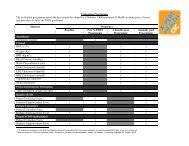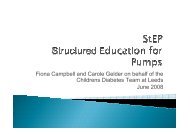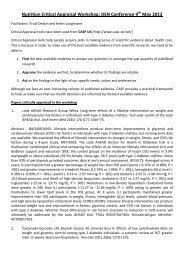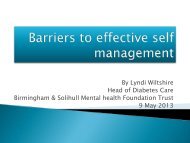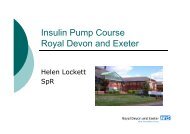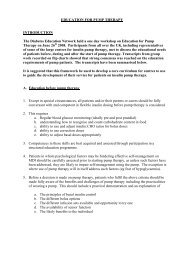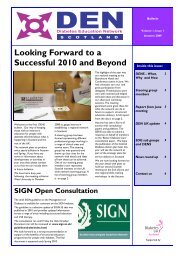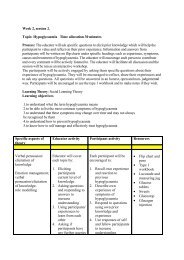Insulin Pump Workbook - The Diabetes Education Network
Insulin Pump Workbook - The Diabetes Education Network
Insulin Pump Workbook - The Diabetes Education Network
Create successful ePaper yourself
Turn your PDF publications into a flip-book with our unique Google optimized e-Paper software.
Calculating Your Basal Rate<br />
You may need approximately 25 - 30% less insulin on a pump than<br />
your present requirements because of the way the insulin is delivered<br />
Working it out:<br />
1. On average, how much short acting insulin are you injecting in<br />
24hours e.g. 24 units<br />
2. How much long acting insulin do you inject in 24 hours e.g. 20<br />
units<br />
3. Add both together to give your pre-pump total daily dose e.g. 44<br />
units<br />
4. Take 30% off pre-pump total daily dose. This is now your total<br />
daily pump dose e.g. 70% of 44 units = 30 units<br />
5. Divide your total daily pump dose by 2 to give your total basal<br />
rate in 24 hours e.g. 30 ÷ 2 = 15 units<br />
6. Divide by 24 to give an hourly basal rate e.g. 15 / 24 = 0.6 units<br />
per hour<br />
Now calculate your basal rate<br />
Short acting insulin =<br />
Long acting insulin =<br />
Total =<br />
-30% =<br />
Divide by 2 =<br />
Divide by 24 = My starting basal rate is…………..<br />
It is usual to start with a flat basal rate but you and<br />
your team may decide differently. <strong>The</strong> pump has the ability to deliver<br />
different basal rates during the 24 hour period. <strong>The</strong>se will be<br />
determined according to your individual needs over the next few<br />
weeks. Most people have between 1 – 6 different basal rates<br />
12



